Hokkaido
| Hokkaido 北海道 | |||
|---|---|---|---|
| Prefecture | |||
| Japanese transcription(s) | |||
| • Japanese | 北海道 | ||
| • Rōmaji | Hokkaidō | ||
| Ainu transcription(s) | |||
| • Ainu | アィヌ・モシリ | ||
| • Rōmaji | Ainu-Mosir | ||
| |||
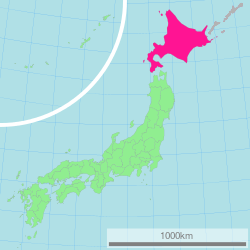 | |||
| Country | Japan | ||
| Region | Hokkaido | ||
| Island | Hokkaido | ||
| Capital | Sapporo | ||
| Government | |||
| • Governor | Harumi Takahashi | ||
| Area | |||
| • Total | 83,453.57 km2 (32,221.60 sq mi) | ||
| Area rank | 1st | ||
| Population (June 30, 2016) | |||
| • Total | 5,381,711 | ||
| • Rank | 8th | ||
| • Density | 64.49/km2 (167.0/sq mi) | ||
| ISO 3166 code | JP-01 | ||
| Districts | 74 | ||
| Municipalities | 179 | ||
| Flower | Hamanasu (rugosa rose, Rosa rugosa) | ||
| Tree | Ezomatsu (Jezo spruce, Picea jezoensis) | ||
| Bird | Tanchō (red-crowned crane, Grus japonensis) | ||
| Fish | Sea bream | ||
| Website |
www | ||
| Native name: <span class="nickname" ">北海道(本島) | |
|---|---|
| Geography | |
| Location | Boundary between northwestern Pacific Ocean, Sea of Japan, and Sea of Okhotsk |
| Coordinates | 43°N 142°E / 43°N 142°E |
| Archipelago | Japanese archipelago |
| Area | 77,981.87 km2 (30,108.97 sq mi) |
| Highest elevation | 2,290 m (7,510 ft) |
| Highest point | Asahi-dake |
| Administration | |
|
Japan | |
| Prefectures | Hokkaido |
| Largest settlement | Sapporo (pop. 1,890,561) |
| Demographics | |
| Population | approx. 5,600,000 |
| Ethnic groups | Ainu, Japanese |
Hokkaido (北海道 Hokkaidō, literally "Northern Sea Circuit") (Japanese: [hokkaidoː]), formerly known as Ezo, Yezo, Yeso, or Yesso, is the second largest island of Japan, and the largest and northernmost prefecture. The Tsugaru Strait separates Hokkaido from Honshu.[1] The two islands are connected by the underwater railway Seikan Tunnel. The largest city on Hokkaido is its capital, Sapporo, which is also its only ordinance-designated city.
History

Hokkaido (北海道) was settled by the Ainu,[2] Nivkh, and Orok before recorded history.[3] The Nihon Shoki, finished in 720 AD, is often said to be the first mention of Hokkaido in recorded history. According to the text, Abe no Hirafu[3] led a large navy and army to northern areas from 658 to 660 and came into contact with the Mishihase and Emishi. One of the places Hirafu went to was called Watarishima (渡島), which is often believed to be present-day Hokkaido. However, many theories exist in relation to the details of this event, including the location of Watarishima and the common belief that the Emishi in Watarishima were the ancestors of the present-day Ainu people.
During the Nara and Heian periods (710–1185), people in Hokkaido conducted trade with Dewa Province, an outpost of the Japanese central government. From the Middle Ages, the people in Hokkaido began to be called Ezo. Hokkaido, formerly known as Ezochi[4] Ezochi (蝦夷地, lit. "Ezo-land") or Ezogashima (蝦夷ヶ島, lit. "Island of the Ezo"). The Ezo mainly relied upon hunting and fishing and obtained rice and iron through trade with the Japanese.
During the Muromachi period (1336–1573), the Japanese created a settlement at the south of the Oshima Peninsula. As more people moved to the settlement to avoid battles, disputes arose between the Japanese and the Ainu. The disputes eventually developed into a war. Takeda Nobuhiro killed the Ainu leader, Koshamain,[3] and defeated the opposition in 1457. Nobuhiro's descendants became the rulers of the Matsumae-han, which was granted exclusive trading rights with the Ainu in the Azuchi-Momoyama and Edo periods (1568–1868). The Matsumae family's economy relied upon trade with the Ainu. They held authority over the south of Ezochi until the end of the Edo period in 1868.
The Matsumae clan rule over the Ainu must be understood in the context of the expansion of the Japanese feudal state. Medieval military leaders in northern Honshū (ex. Northern Fujiwara, Akita clan) maintained only tenuous political and cultural ties to the imperial court and its proxies, the Kamakura Shogunate and Ashikaga Shogunate. Feudal strongmen sometimes located themselves within medieval institutional order, taking shogunal titles, while in other times they assumed titles that seemed to give them a non-Japanese identity. In fact many of the feudal strongmen were descended from Emishi military leaders who had been assimilated into Japanese society.[5] The Matsumae clan were of Yamato descent like other ethnic Japanese people, whereas the Emishi of northern Honshu where a distinctive group related to the Ainu. The Emishi were conquered and integrated into the Japanese state dating back as far as the 8th century, and as result began to lose their distinctive culture and ethnicity as they became minorities. By the time the Matsumae clan ruled over the Ainu most of the Emishi were ethnically mixed and physically closer to Japanese than they were to Ainu. This dovetails nicely with the "transformation" theory that native Jōmon peoples changed gradually with the infusion of Yayoi immigrants into the Tōhoku rather than the "replacement" theory which posits that one population (Jōmon) was replaced by another (Yayoi).[6]

There were numerous revolts by the Ainu against feudal rule. The last large-scale resistance was Shakushain's Revolt in 1669–1672. In 1789, a smaller movement, the Menashi-Kunashir Rebellion, was also crushed. After that rebellion the terms "Japanese" and "Ainu" referred to clearly distinguished groups, and the Matsumae were unequivocally Japanese. In 1799–1821 and 1855–1858 the Edo Shogunate took direct control over Hokkaido in response to a perceived threat from Russia.
Leading up to the Meiji Restoration, the Tokugawa Shogunate realized there was a need to prepare northern defenses against a possible Russian invasion and took over control of most of Ezochi. The Shogunate made the plight of the Ainu slightly easier, but did not change the overall form of rule.[7]
Hokkaido was known as Ezochi until the Meiji Restoration. Shortly after the Boshin War in 1868, a group of Tokugawa loyalists led by Enomoto Takeaki temporarily occupied the island (the polity is commonly but mistakenly known as the Republic of Ezo), but the rebellion was crushed in May 1869. Ezochi was subsequently put under control of Hakodate-fu (箱館府), Hakodate Prefectural Government. When establishing the Development Commission (開拓使 Kaitakushi), the Meiji Government introduced a new name. After 1869, the northern Japanese island was known as Hokkaido;[1] and regional subdivisions were established, including the provinces of Oshima, Shiribeshi, Iburi, Ishikari, Teshio, Kitami, Hidaka, Tokachi, Kushiro, Nemuro and Chishima.[8]
The primary purpose of the development commission was to secure Hokkaido before the Russians extended their control of the Far East beyond Vladivostok. Kuroda Kiyotaka was put in charge of the venture. His first step was to journey to the United States and recruit Horace Capron, President Grant's Commissioner of Agriculture. From 1871 to 1873 Capron bent his efforts to expounding Western agriculture and mining with mixed results. Capron, frustrated with obstacles to his efforts returned home in 1875. In 1876, William S. Clark arrived to found an agricultural college in Sapporo. Although he only remained a year, Clark left lasting impression on Hokkaido, inspiring the Japanese with his teachings on agriculture as well as Christianity.[9] His parting words, "Boys, be ambitious!" can be found on public buildings in Hokkaido to this day. The population of Hokkaido boomed from 58,000 to 240,000 during that decade.[10]
In 1882, the Development Commission was abolished, and Hokkaido was separated into three prefectures -- Hakodate Prefecture (函館県 Hakodate-ken), Sapporo Prefecture (札幌県 Sapporo-ken), and Nemuro Prefecture (根室県 Nemuro-ken). In 1886, the three prefectures were abolished, and Hokkaido was put under the Hokkaido Agency (北海道庁 Hokkaidō-chō). Hokkaido became equal with other prefectures in 1947, when the revised Local Autonomy Law became effective. The Japanese central government established the Hokkaido Development Agency (北海道開発庁 Hokkaidō Kaihatsuchō) as an agency of the Prime Minister's Office in 1949 to maintain its executive power in Hokkaido. The Agency was absorbed by the Ministry of Land, Infrastructure and Transport in 2001. The Hokkaido Bureau (北海道局 Hokkaidō-kyoku) and the Hokkaido Regional Development Bureau (北海道開発局 Hokkaidō Kaihatsukyoku) of the Ministry still have a strong influence on public construction projects in Hokkaido.
In mid-July 1945 shipping, cities and military facilities in Hokkaido were attacked by the United States Navy's Task Force 38. On 14 and 15 July aircraft operating from the task force's aircraft carriers sank and damaged a large number of ships in ports along Hokkaido's southern coastline as well as in northern Honshu. In addition, on 15 July a force of three battleships and two light cruisers bombarded the city of Muroran.[11]
Naming of Hokkaido
When establishing the Development Commission (開拓使 Kaitakushi), the Meiji Government decided to change the name of Ezochi. Matsuura Takeshirō submitted six proposals, including names such as Kaihokudō (海北道?) and Hokkaidō (北加伊道?) , to the government. The government eventually decided to use the name Hokkaidō, but decided to write it as 北海道, as a compromise between 海北道 and because of the similarity with names such as Tōkaidō (東海道). According to Matsuura, the name was thought up because the Ainu called the region Kai. Historically, many peoples who had interactions with the ancestors of the Ainu called them and their islands Kuyi, Kuye, Qoy, or some similar name, which may have some connection to the early modern form Kai. The Kai element also strongly resembles the Sino-Japanese reading of the characters 蝦夷 (Sino-Japanese Japanese pronunciation: [ka.i], Japanese kun'yomi [emisi]), which have been used for over a thousand years in China and Japan as the standard orthographic form to be used when referring to Ainu and related peoples; it is possible that Matsuura's Kai was actually an alteration, influenced by the Sino-Japanese reading of 蝦夷 Ka-i, of the Nivkh exonym for the Ainu, namely Qoy or IPA: [kʰuɣi].[12]
There is no known established Ainu language word for the island of Hokkaido. However, the Ainu people did have a name for all of their domain, which included Hokkaido along with the Kuril Islands, Sakhalin, and parts of northern Honshu, which was Aynu Mosir (アィヌ・モシリ), a name taken by the modern Ainu to refer to their traditional homeland.[13][14][15][16][17] "Ainu Mosir" literally translates as "The Land Where People (the Ainu) Live", and it was traditionally used to be contrasted with Kamuy Mosir, "The Land of the Kamuy (spirits)".[18]
Geography
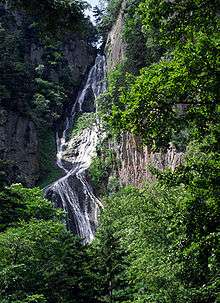

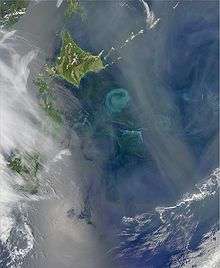
The island of Hokkaido is located at the north end of Japan, near Russia, and has coastlines on the Sea of Japan, the Sea of Okhotsk, and the Pacific Ocean. The center of the island has a number of mountains and volcanic plateaus, and there are coastal plains in all directions. Major cities include Sapporo and Asahikawa in the central region and the port of Hakodate facing Honshu.
The governmental jurisdiction of Hokkaido incorporates several smaller islands, including Rishiri, Okushiri Island, and Rebun. (By Japanese reckoning, Hokkaido also incorporates several of the Kuril Islands.) Because the prefectural status of Hokkaido is denoted by the dō in its name, it is rarely referred to as "Hokkaido Prefecture", except when necessary to distinguish the governmental entity from the island.
The island ranks 21st in the world by area. It is 3.6% smaller than the island of Ireland while Hispaniola is 6.1% smaller than Hokkaido. By population it ranks 20th, between Ireland and Sicily. Hokkaido's population is 4.7% less than that of the island of Ireland, and Sicily's is 12% lower than Hokkaido's.
In the east, there are two areas (surrounding, for example, Shari and the Nakashibetsu Airport) where a grid with spacing of nearly 3 km is formed by narrow bands of forest. It was designed to buffer wind, especially during blizzards, to protect cattle. It also serves as habitat and transportation corridors for animals and hikers.
Seismic activity
Like many areas of Japan, Hokkaido is seismically active. Aside from numerous earthquakes, the following volcanoes are still considered active (at least one eruption since 1850):
In 1993, an earthquake of magnitude 7.7 generated a tsunami which devastated Okushiri, killing 202. An earthquake of magnitude 8.3 struck near the island on 26 September 2003.
National parks and quasi-national parks
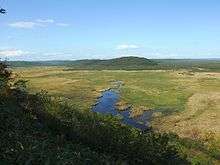
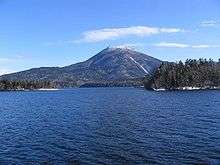


There are still many undisturbed forests in Hokkaido, including:
| Shiretoko National Park* | 知床 |
| Akan National Park | 阿寒 |
| Kushiro-shitsugen National Park | 釧路湿原 |
| Daisetsuzan National Park | 大雪山 |
| Shikotsu-Tōya National Park | 支笏洞爺 |
| Rishiri-Rebun-Sarobetsu National Park | 利尻礼文サロベツ |
* designated a World Heritage Site by UNESCO on 2005-07-14.
| Abashiri Quasi-National Park | 網走 |
| Hidaka-sanmyaku Erimo Quasi-National Park | 日高山脈襟裳 |
| Niseko-Shakotan-Otaru Kaigan Quasi-National Park | ニセコ積丹小樽海岸 |
| Ōnuma Quasi-National Park | 大沼 |
| Shokanbetsu-Teuri-Yagishiri Quasi-National Park | 暑寒別天売焼尻 |
- Twelve prefectural natural parks (道立自然公園). The prefectural natural parks cover 146,802 ha, the largest area of any prefecture.[19]
- Akkeshi Prefectural Natural Park
- Esan Prefectural Natural Park
- Furano-Ashibetsu Prefectural Natural Park
- Hiyama Prefectural Natural Park
- Kariba-Motta Prefectural Natural Park
- Matsumae-Yagoshi Prefectural Natural Park
- North Okhotsk Prefectural Natural Park
- Nopporo Shinrin Kōen Prefectural Natural Park
- Notsuke-Fūren Prefectural Natural Park
- Sharidake Prefectural Natural Park
- Shumarinai Prefectural Natural Park
- Teshiodake Prefectural Natural Park
| since | ||
|---|---|---|
| Kushiro Wetland | 釧路湿原 | 1980-06-17 |
| Lake Kutcharo | クッチャロ湖 | 1989-07-06 |
| Lake Utonai | ウトナイ湖 | 1991-12-12 |
| Kiritappu Wetland | 霧多布湿原 | 1993-06-10 |
| Lake Akkeshi, Bekkanbeushi Wetland | 厚岸湖・別寒辺牛湿原 | 1993-06-10, enlarged 2005-11-08 |
| Miyajima Marsh | 宮島沼 | 2002-11-18 |
| Uryūnuma Wetland | 雨竜沼湿原 | 2005-11-08 |
| Sarobetsu plain | サロベツ原野 | |
| Lake Tōfutsu | 濤沸湖 | |
| Lake Akan | 阿寒湖 | |
| Notsuke Peninsula, Notsuke Bay | 野付半島・野付湾 | |
| Lake Fūren, Shunkunitai | 風蓮湖・春国岱 |
Wildlife
There are three populations of the Hokkaido brown bear subspecies (Ursus arctos yesoensis). There are more brown bears than anywhere else in Asia besides Russia. The Hokkaido brown bear is separated into three distinct lineages. There are only eight lineages in the world.[20] Those on Honshu died out long ago.
Sub prefectures
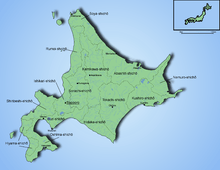

1
a
2
3
b
4
c
5
d
6
7
8
9
e
(disputed)
(disputed)
| |||||||||
| Subprefecture | Japanese | Capital | Largest city | Pop. (2009) |
Area (km2) |
Municipalities | |||
|---|---|---|---|---|---|---|---|---|---|
| 1 | Sorachi | 空知総合振興局 | Iwamizawa | Iwamizawa | 338,485 | 5,791.19 | 10 cities | 14 towns | |
| a | ↳ Ishikari | 石狩振興局 | Sapporo | Sapporo | 2,324,878 | 3,539.86 | 6 cities | 1 town | 1 village |
| 2 | Shiribeshi | 後志総合振興局 | Kutchan | Otaru | 234,984 | 4,305.83 | 1 city | 13 towns | 6 villages |
| 3 | Iburi | 胆振総合振興局 | Muroran | Tomakomai | 419,115 | 3,698.00 | 4 cities | 7 towns | |
| b | ↳ Hidaka | 日高振興局 | Urakawa | Shinhidaka | 76,084 | 4,811.97 | 7 towns | ||
| 4 | Oshima | 渡島総合振興局 | Hakodate | Hakodate | 433,475 | 3,936.46 | 2 cities | 9 towns | |
| c | ↳ Hiyama | 檜山振興局 | Esashi | Setana | 43,210 | 2,629.94 | 7 towns | ||
| 5 | Kamikawa | 上川総合振興局 | Asahikawa | Asahikawa | 527,575 | 10,619.20 | 4 cities | 17 towns | 2 villages |
| d | ↳ Rumoi | 留萌振興局 | Rumoi | Rumoi | 53,916 | 3,445.75 | 1 city | 6 towns | 1 village |
| 6 | Sōya | 宗谷総合振興局 | Wakkanai | Wakkanai | 71,423 | 4,625.09 | 1 city | 8 towns | 1 village |
| 7 | Okhotsk | オホーツク総合振興局 | Abashiri | Kitami | 309,487 | 10,690.62 | 3 cities | 14 towns | 1 village |
| 8 | Tokachi | 十勝総合振興局 | Obihiro | Obihiro | 353,291 | 10,831.24 | 1 city | 16 towns | 2 villages |
| 9 | Kushiro | 釧路総合振興局 | Kushiro | Kushiro | 252,571 | 5,997.38 | 1 city | 6 towns | 1 village |
| e | ↳ Nemuro | 根室振興局 | Nemuro | Nemuro | 84,035 | 3,406.23 | 1 city | 4 towns | |
| * Japan claims the southern part of Kuril Islands (Northern Territories), currently administered by Russia, belong to Nemuro Subprefecture divided into six villages. However, the table above excludes these islands' data. | |||||||||
From April 2010, Hokkaido has 9 General Subprefectural Bureaus (総合振興局) and 5 Subprefectural Bureaus (振興局). Prior to that, Hokkaido is one of eight prefectures in Japan that have subprefectures (支庁 shichō). However, it is the only one of the eight to have such offices covering the whole of its territory outside the main cities (rather than having them just for outlying islands or remote areas). This is mostly due to its great size: many parts of the prefecture are simply too far away to be effectively administered by Sapporo. Subprefectural offices in Hokkaido carry out many of the duties that prefectural offices fulfill elsewhere in Japan.
Before the current political divisions and after 1869, Hokkaido was divided into provinces. See Former provinces of Hokkaido.
Climate

Hokkaido has relatively cool summers and icy/snowy winters. Most of the island falls in the humid continental climate zone with Köppen climate classification Dfb (hemiboreal) in most areas but Dfa (hot summer humid continental) in some inland lowlands. The average August temperature ranges from 17 to 22 °C (62.6 to 71.6 °F), while the average January temperature ranges from −12 to −4 °C (10.4 to 24.8 °F), in both cases depending on elevation and distance from the ocean, though temperatures on the western side of the island tend to be a little warmer than on the eastern.
The northern portion of Hokkaido falls into the taiga biome,[21] with significant snowfall. Snowfall varies widely from as much as 11 metres (400 in) on the mountains adjacent to the Sea of Japan down to around 1.8 metres (71 in) on the Pacific coast. The island tends to see isolated snowstorms that develop long-lasting snowbanks, in contrast to the constant flurries seen in the Hokuriku region. Total precipitation varies from 1,600 millimetres (63 in) on the mountains of the Sea of Japan coast to around 800 millimetres (31 in) (the lowest in Japan) on the Sea of Okhotsk coast and interior lowlands and up to around 1,100 millimetres (43 in) on the Pacific side.
Unlike the other major islands of Japan, Hokkaido is normally not affected by the June–July rainy season and the relative lack of humidity and typically warm, rather than hot, summer weather makes its climate an attraction for tourists from other parts of Japan.
In winter, the generally high quality of powder snow and numerous mountains in Hokkaido make it a popular region for snow sports. The snowfall usually commences in earnest in November and ski resorts (such as those at Niseko, Furano, Teine and Rusutsu) usually operate between December and April. Hokkaido celebrates its winter weather at the Sapporo Snow Festival.
During the winter, passage through the Sea of Okhotsk is often complicated by large floes of drift ice. Combined with high winds that occur during winter, this frequently brings air travel and maritime activity to a halt beyond the northern coast of Hokkaido. Ports on the open Pacific Ocean and Sea of Japan are generally ice-free year round, though most rivers freeze during the winter.
Major cities and towns

Hokkaido's largest city is the capital, Sapporo, which is a designated city. The island has two core cities: Hakodate in the south and Asahikawa in the central region. Other important population centers include Kushiro, Obihiro, Kitami, Abashiri, Wakkanai, and Nemuro.
Hokkaido has the highest rate of depopulation in Japan. In 2000, 152 (71.7%) of Hokkaido's 212 municipalities were shrinking. Altogether, shrinking municipalities in Japan in the same year numbered 1,171.
Economy

Although there is some light industry (most notably paper milling and beer brewing) most of the population is employed by the service sector. In 2001, the service sector and other tertiary industries generated more than three-quarters of the gross domestic product.[22]
However, agriculture and other primary industries play a large role in Hokkaido's economy. Hokkaido has nearly one fourth of Japan's total arable land. It ranks first in the nation in the production of a host of agricultural products, including wheat, soybeans, potatoes, sugar beet, onions, pumpkins, corn, raw milk, and beef. Hokkaido also accounts for 22% of Japan's forests with a sizable timber industry. The prefecture is also first in the nation in production of marine products and aquaculture.[22]
Tourism is an important industry, especially during the cool summertime when visitors are attracted to Hokkaido's open spaces from hotter and more humid parts of Japan and other Asian countries. During the winter, skiing and other winter sports bring other tourists, and increasingly international ones, to the island.[23]
Transportation
Hokkaido's only land link to the rest of Japan is the Seikan Tunnel. Most travellers travel to the island by air: the main airport is New Chitose Airport at Chitose, just south of Sapporo. Tokyo-Chitose is in the top 10 of the world's busiest air routes, handling more than 40 widebody round trips on several airlines each day. One of the airlines, Air Do was named after Hokkaido. Hokkaido can also be reached by ferry from Sendai, Niigata and some other cities, with the ferries from Tokyo dealing only in cargo.
Within Hokkaido, there is a fairly well-developed railway network (see Hokkaido Railway Company), but many cities can only be accessed by road.
Hokkaido is home to one of Japan's three Melody Roads, which is made from grooves cut into the ground, which when driven over causes a tactile vibration and audible rumbling transmitted through the wheels into the car body.[24][25]
Education
The Hokkaido Prefectural Board of Education oversees public schools (except colleges and universities) in Hokkaido. Public elementary and junior high schools (except Hokkaido Noboribetsu Akebi Secondary School and schools attached to Hokkaido University of Education) are operated by municipalities, and public high schools are operated by either the prefectural board or municipalities.
Hokkaido has 37 universities (7 national, 5 local public, and 25 private universities), 34 junior colleges, and 5 colleges of technology (4 national and 1 local public colleges). National universities located in Hokkaido are:
- Hokkaido University (former Sapporo Agricultural College)[26]
- Hokkaido University of Education
- Muroran Institute of Technology
- Otaru University of Commerce
- Obihiro University of Agriculture and Veterinary Medicine
- Asahikawa Medical University
- Kitami Institute of Technology
Hokkaido government runs Sapporo Medical University, a medical school in Sapporo.
Sports
The 1972 Winter Olympics were held in Sapporo.
The sports teams listed below are based in Hokkaido.
American football
Association football
Baseball
Basketball
Ice hockey
Winter festivals
- Sapporo Snow Festival
- Asahikawa Snow Festival
- Sōunkyō Ice Festival
- Big Air - snowboarding freestyle competition
International relations
Hokkaido has relationships with several provinces, states, and other entities worldwide.[27]
-
 Alberta, Canada, since 1980[28][29]
Alberta, Canada, since 1980[28][29] -
 Heilongjiang, China, since 1980[28]
Heilongjiang, China, since 1980[28] -
 Massachusetts, USA, since 1988[28][30]
Massachusetts, USA, since 1988[28][30] -
 Sakhalin Oblast, Russia, since 1998[28]
Sakhalin Oblast, Russia, since 1998[28] -
 Busan, South Korea, since 2005
Busan, South Korea, since 2005 -
 Gyeongsangnam-do, South Korea, since 2006
Gyeongsangnam-do, South Korea, since 2006 -
 Seoul, South Korea, since 2010[31]
Seoul, South Korea, since 2010[31]
As of January 2014, 74 individual municipalities in Hokkaido have sister city agreements with 114 cities in 21 different countries worldwide.[32]
Politics
Governor
The current governor of Hokkaido is Harumi Takahashi. She won a fourth term in the gubernatorial election in 2015 with centre-right support. Her first election in 2003 in a close race against centre-left supported Yoshio Hachiro and seven other candidates ended a 20-year streak of victories by Socialist Party heavyweight Takahiro Yokomichi and then his former vice governor Tatsuya Hori who beat Hideko Itō twice by large margins. Itō, a former Socialist Diet member was supported by the Liberal Democratic Party against Hori in 1995 (at the time, Socialists and Liberal Democrats formed the ruling "grand" coalition on the national level); In 1999, Hori was supported by all major non-Communist parties and Itō ran without party support. Before 1983, the governorship had been held by Liberal Democrats Naohiro Dōgakinai and Kingo Machimura for 24 years. In the 1971 election when Machimura retired, the Socialist candidate Shōhei Tsukada lost to Dōgakinai by only 13,000 votes;[33] Tsukada was also supported by the Communist Party – the leftist cooperation in opposition to the US-Japanese security treaty had brought joint Socialist-Communist candidates to victory in many other prefectural and local elections in the 1960s and 1970s. In 1959, Machimura had defeated Yokomichi's father Setsuo in the race to succeed Hokkaido's first elected governor, Socialist Toshibumi Tanaka who retired after three terms. Tanaka had only won the governorship in 1947 in a run-off election against Democrat Eiji Arima because no candidate had received the necessary vote share to win in the first round as required by law at the time.
Assembly
The Hokkaido Prefectural Assembly has 101 members from 47 electoral districts. As of April 30, 2015, the LDP caucus holds a majority with 51 seats, the DPJ-led group has 26 members. Other groups are the Hokkaidō Yūshikai of New Party Daichi and independents with twelve seats, Kōmeitō with eight, and the Japanese Communist Party with four members.[34] General elections for the Hokkaido assembly are currently held together with gubernatorial elections in the unified local elections (last round: April 2015).
National representation
For the lower house of the National Diet, Hokkaido is divided into twelve single-member electoral districts. In the 2014 election, candidates from the governing coalition of Liberal Democrats and New Komeito won nine districts, Democrats three. For the proportional election segment, Hokkaido and Tokyo are the only two prefectures that form a regional "block" district of their own. The Hokkaido proportional representation block elects eight Representatives. In 2014, the Liberal Democratic Party received 29.8% of the proportional vote and won three seats, the Democratic Party won two (27.6% of the vote), one seat each went to Kōmeitō (12.3%), Japan Innovation Party (9.9%) and – for the first time since the 2000 lower house election – the Japanese Communist Party (12.1%). More than four percent of Hokkaidō proportional votes in 2014 went to a minor protest group named shiji seitō nashi ("no party supported"/"[I/we] support no party").
In the upper house of the National Diet, a major reapportionment in the 1990s halved the number of Councillors from Hokkaido per election from four to two. After the elections of 2010 and 2013, the Hokkaido electoral district – like most two-member districts for the upper house – is represented by two Liberal Democrats and two Democrats. In the 2016 upper house election, the district magnitude will be raised to three, Hokkaidō will then temporarily be represented by five members and six after the 2019 election.
See also

- 2006 Kuril Islands earthquake
- Asia League Ice Hockey
- Former Hokkaido government office building
- Kuril Islands dispute
- People from Hokkaido
- Sankebetsu brown bear incident
- Hokkaido dialects
- Red-crowned crane
Notes
- 1 2 Nussbaum, Louis-Frédéric. (2005). "Hokkaido" in Japan Encyclopedia, p. 343, p. 343, at Google Books
- ↑ "Recognition at last for Japan's Ainu ". BBC News. July 6, 2008
- 1 2 3 Japan Handbook, p. 760
- ↑ McClain, James L. (2002). Japan, A Modern History (First ed.). New York, N.Y.: W.W. Norton & Company. p. 285. ISBN 0-393-04156-5.
- ↑ Howell, David. "Ainu Ethnicity and the Boundaries of the Early Modern Japanese State", Past and Present 142 (February 1994), p. 142
- ↑ Ossenberg, Nancy (see reference) has the best evidence of this relationship with the Jōmon. Also, a newer study, Ossenberg, et al., "Ethnogenesis and craniofacial change in Japan from the perspective of nonmetric traits" (Anthropological Science v.114:99-115) is an updated analysis published in 2006 which confirms this finding.
- ↑ Nakamura, Akemi, "Japan's last frontier took time to tame, cultivate image", The Japan Times, 8 July 2008, p. 3.
- ↑ Satow, Ernest. (1882). "The Geography of Japan" in Transactions of the Asiatic Society of Japan, Vols. 1–2, p. 88., p. 33, at Google Books
- ↑ McDougall, Walter A. (1993). Let the Sea Make a Noise, pp. 355–356.
- ↑ McDougall, p. 357.
- ↑ "Chapter VII: 1945". The Official Chronology of the US Navy in World War II. Hyperwar. Retrieved 20 September 2011.
- ↑ "Chapter 3: Nivkh as an Aspiration Language," p. 53 RUG.nl
- ↑ "Ainu Mosir. The land of human beings - Nanni Fontana - photographer". Nanni Fontana. Retrieved 2012-09-14.
- ↑ July.04.2008 (2008-07-04). "ICU Students Support Indigenous Peoples Summit in Ainu Mosir 2008 « ICU BackNumbersite". Web.icu.ac.jp. Retrieved 2012-09-14.
- ↑ "Indigenous Peoples Summit in Ainu Mosir 2008 * News". Win-ainu.com. Retrieved 2012-09-14.
- ↑ Lewallen, Ann-Elise (November 30, 2008). "Indigenous at last! Ainu Grassroots Organizing and the Indigenous Peoples Summit in Ainu Mosir". The Asia-Pacific Journal: Japan Focus. 48-6-08. Retrieved September 14, 2012.
- ↑ Okada, Mitsuharu Vincent (2012). "The Plight of Ainu, Indigenous People of Japan" (PDF). Journal of Indigenous Social Development. University of Hawaii. 1 (1): 1–14. Retrieved September 14, 2012.
- ↑ "National Museum of Ethnology, Japan: Permanent Exhibitions". Retrieved 2011-08-26.
- ↑ "General overview of area figures for Natural Parks by prefecture" (PDF). Ministry of the Environment Japan. 31 March 2008. Retrieved 2009-06-02.
- ↑ Hirata, Daisuke; et al. (2013). "Molecular Phylogeography of the Brown Bear (Ursus arctos) in Northeastern Asia Based on Analyses of Complete Mitochondrial DNA Sequences". Mol Biol Evol. 30 (7): 1644–1652. doi:10.1093/molbev/mst077. Retrieved 18 March 2015.
- ↑ C.Michael Hogan. 2011. Taiga. eds. M.McGinley & C.Cleveland. Encyclopedia of Earth. National Council for Science and the Environment. Washington DC
- 1 2 "Hokkaido's Business Environment". Trade and Economic Exchange Group, Commerce and Economic Exchange Division, Department of Economic Affairs, Hokkaido Government. Archived from the original on 2010-07-21. Retrieved 2008-12-05.
- ↑ Takahara, Kanako (July 8, 2008). "Boom time for Hokkaido ski resort area". The Japan Times. The Japan Times Ltd. Retrieved 2008-09-27.
- ↑ Johnson, Bobbie (13 November 2007). "Japan's melody roads play music as you drive". The Guardian. Farringdon Road, London, England: GMG. p. 19 (International section). Retrieved 2008-10-20.
- ↑ "Your car as a musical instrument - Melody Roads". Noise Addicts. 29 September 2008. Retrieved 20 October 2008.
- ↑ Nussbaum, "Hokkaido Daigaku" in p. 343, p. 343, at Google Books
- ↑ "Exchange Affiliates". Retrieved on 5 December 2008.
- 1 2 3 4 "Hokkaido – Alberta Relations" (PDF). Retrieved 2010-05-30.
- ↑ "Alberta Sport, Recreation, Parks & Wildlife Foundation". Retrieved 2010-05-30.
- ↑ "Massachusetts Hokkaido Association". Retrieved 2010-05-30.
- ↑ "ソウル特別市との交流". Retrieved 2013-11-03.
- ↑ 市町村の姉妹友好提携 (Sister city partnerships). Retrieved on 3 November 2013. (Japanese)
- ↑ Hokkaido prefectural government: Gubernatorial election results since 1947 (Japanese)
- ↑ Hokkaido Prefectural Assembly: Members by electoral district and parliamentary group (Japanese)
^[note 1] Source: English edition of Sightseeing in Hokkaido, Winter Festival and Events
Bibliography
- Bisignani, J. D. (1993). Japan Handbook. Chico, California: Moon Publications. ISBN 9780960332229; ISBN 9780908054145; OCLC 8954556
- McDougall, Walter A. (1993). Let the Sea Make a Noise: A History of the North Pacific from Magellan to MacArthur. New York: Basic Books. ISBN 9780465051526; OCLC 28017793
- Nussbaum, Louis-Frédéric and Käthe Roth. (2005). Japan encyclopedia. Cambridge: Harvard University Press. ISBN 978-0-674-01753-5; OCLC 58053128
- John Batchelor; Japanese Central Association (1893). An itinerary of Hokkaido, Japan, Volume 1. Tokyo: Hakodate Chamber of Commerce.
External links
| Wikimedia Commons has media related to Hokkaido. |
| Look up Hokkaido in Wiktionary, the free dictionary. |
| Wikivoyage has a travel guide for Hokkaido. |
- Hokkaido official website (Japanese)
- Hokkaido Official website (English)
Coordinates: 43°N 142°E / 43°N 142°E


